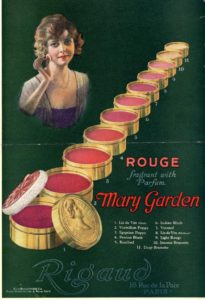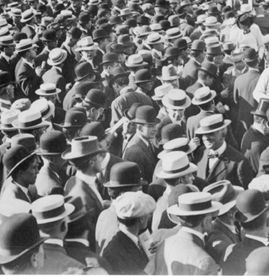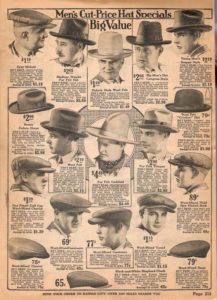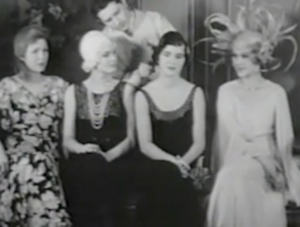Fashion in 1920 Bootleggers 1920 Drawings Newspapers





Prohibition Sparked a Women's Mode Revolution
Bobs, beads and higher hemlines — these are all features nosotros conjure up near women'southward manner during Prohibition. Iconic images of flappers dancing the Charleston float through our minds likewise, but what divers an "It" girl during this menstruation? What prompted these women to abandon the styles of their Victorian-era mothers? No more than restrictive dresses, corsets or flooring-length gowns — fashionable women of the Prohibition era craved liberty of movement in their clothing.
Flapper fashion did non emerge suddenly. Information technology adult as a result of gradual social and cultural changes. During this period, youth and beauty became a valued commodity. For the get-go time women were being marketed to in loftier book, which boosted the sales of cosmetics and perfumes. Americans had more expendable income, and then they were able to buy more than consumer goods.
During the flapper era, women wanted sheer, moveable fabric with a dropped waistline and a squared body. The mixing of fabrics for evening wear (for a date or to visit a speakeasy) became very pop. Dresses could be ornately decorated with glass beads, rhinestones, furs and fabric flowers.
The typical silhouette of a flapper was thin with bare arms and ankles, merely a covered acme. These women embraced the "boy body" with flat chests. Beginning in the early 20th century, women began "working out" at health and beauty clubs, which helped them slim down and achieve the stylish slender body. Smoking also came into fashion for women during this period, as cigarettes were marketed as an appetite suppressant.
The female person form was suppressed with dropped waistlines, looser fits and boxier clothing. Many women were not comfortable baring it all (their arms) so they had sheer fabric, such as early forms of rayon, as sleeves of varying length. Shawls had a resurgence throughout this menses because they were practical for transportation and travel, easy to wear over typical 1920s evening wear and could continue women warm while in an open automobile.
Cloche hats and cropped pilus were quintessential features of the flapper. Bobbed or shorter women's hair was a huge modify not only in way just as a meaning form of female assertion. Women had to invade men's space (the hairdresser) and cut off their hair, which had been a male person-imposed determinant of their sexuality. Some women did not bob their hair simply pinned it up with bobby pins to be trendy. Cloche hats were important considering they were worn only by women who truly had brusk hair.
The evolution of the hemline from long to "brusk"-long was one of the most interesting fashion trends during the Prohibition era. Hemlines rose to the ankle during the 1910s and held steady at calf length. Skirts were still long compared with contemporary styles, but illusion hemlines were created to make information technology look similar a flapper was showing more than leg. By the mid-1920s the hemline striking its best loftier — to the kneecap. Near the finish of Prohibition skirts began to lengthen, over again assisted by asymmetrical hemlines. Several different fabrics were needed to achieve this expect. Semi-sheer overskirts, pleats and scalloped skirts assisted with hemline deception. To complement the different hemlines young women wore flesh-colored stockings to give the illusion of a blank leg. It was also fashionable to wear patterned stockings.
Men of the era typically wore three-piece suits — vests were required. Men's suits were mostly thick materials such every bit wool or flannel, simply still lighter material than mutual in previous decades. Suits were known for having three to 4 buttons, the top of which rested on the homo's center and gave the adapt a college lapel than in previous decades. Toward the end of Prohibition, men'south suits, like women's dresses, became boxy and looser, moving away from the tailored male person silhouette. To complete the ensemble, men wore thin bowties, a fedora or gambler hat, and wingtip shoes.
Side by side Story: Dating Replaced Courtship During Prohibition
0 Response to "Fashion in 1920 Bootleggers 1920 Drawings Newspapers"
Post a Comment